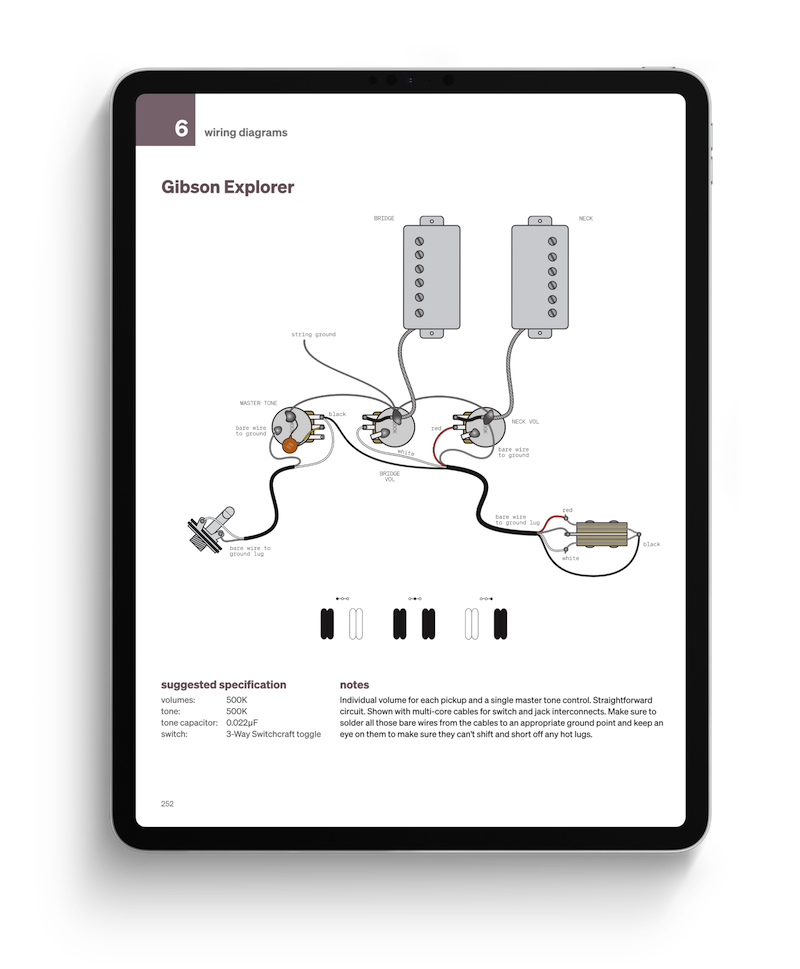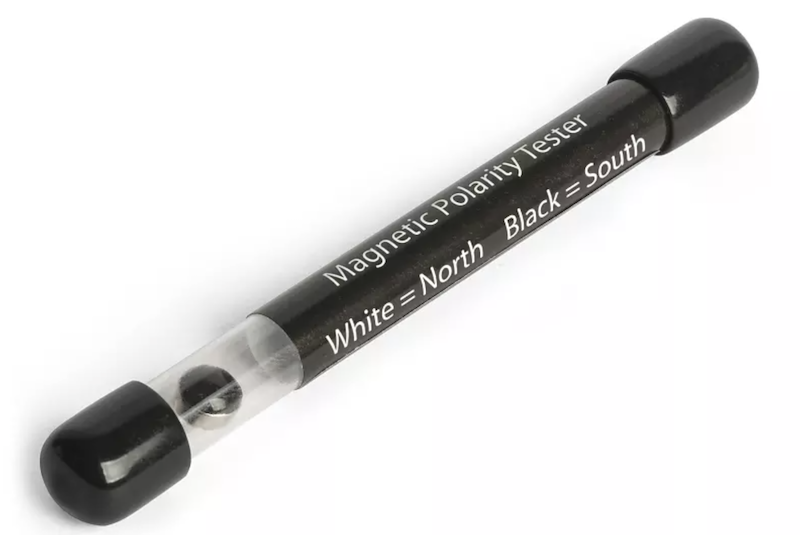Gerry Hayes has been repairing instruments at Haze Guitars on the western outskirts of Dublin, Ireland, for a few decades, and his email newsletter is a source of friendly, informed, and entertaining stuff on the subject. Now he’s channeled all that experience and effort into an excellent book, Complete Guitar Wiring. It’s a detailed, useful guide that I recommend to any guitarists who want to find out what makes their instruments go. Or, more to the point, how to work out what to do when they will not go.
"Probably the subject that throws most people," Gerry says, "is phase relationships in pickups. Two pickups can be in or out of phase depending on a couple of things: their magnetic polarity, which is whether the coil is north or south in polarity, and their electrical polarity, which is really a function of how the coil is wound, so generally we would say that’s clockwise or counter-clockwise."
We’ll have Gerry tell us some more about that thorny area in a moment. But he reckons the first thing to consider if you want to up your guitar-wiring game is the way the circuitry in your guitar actually works. "It’s one thing to be able to follow a wiring diagram, like the one you get when you buy new pickups, but it’s another to be able to understand what’s going on under the hood, so that if you put in a new pickup and it’s not working, you have some ideas about how to troubleshoot that."

One of the many useful parts of Gerry’s book is called Let’s Build A Circuit, where he expands from a very simple layout with just one pickup heading out to an amp and gradually adds in other components—volume and tone pots, capacitors, extra pickups and their switches, and so on—helping you along the way to understand what they all do.
"An electrical circuit is electricity moving around in a circle," he tells me. "A circuit is simply an electron flowing from one point all the way through to an amp and then back to essentially the same point it started out. Just knowing that can give a boost to your troubleshooting, because you know that as well as being able to get out, it has to have a return path—so you need to look at your ground wires and so on, too, when you’re trying to figure out why stuff isn’t working."
He says none of this is overly complicated, and his book underlines this with its clear explanations. There are sections on all the bits and pieces associated with electrics and electric-acoustics, as much as you could wish for on wiring techniques and troubleshooting, 100 wiring diagrams from Chapman to Yamaha, advice on further mods, a catch-all appendix, and—thank goodness—a decent index.
"You don’t need a degree in rocket science to be able to understand the components in most guitars," he says with a smile. "Grasping that goes a huge way towards knowing what’s happening when something goes wrong. And that’s the thing that keeps most players from tweaking their own wiring. You know: ‘If it goes wrong, what the hell do I do?’" That’s the kind of hands-in-the-air frustration that this book aims to fix.

A multimeter, Gerry says, is the key tool that will help you understand what the hell to do when something goes wonky. "A multimeter is a number of different electronic testing apparatuses built into one. It has features that can help electricians and others who need to delve deeper into the electronic side than most guitarists need to, and to be honest we can ignore most of that. But there are a couple of things that are massively useful."
First is a multimeter’s continuity function, which tests whether a low-resistance electrical path exists between two points. "Your multimeter will have two probes," he explains, "and if you stick one at one end of a wire and one at the other end, the continuity tester will tell you whether an electrical signal can travel along that wire, usually by beeping at you. If the wire is broken in the middle, there’ll be no continuity and no response from the multimeter."
In other words, it can help you work out exactly where the problem might be. It’s fine for those basic tests, but not very useful if you need to test, say, a pickup or a volume pot, because it’s expecting almost no resistance. "So we would pop up from the continuity setting to the resistance setting on the multimeter, and that will give us a resistance reading on its screen. That’s good for telling us if a pickup is working properly, for example."

The resistance reading can also provide a basic idea of a pickup’s output, telling you roughly how hot (or not) it might be. "Getting comfortable with using a multimeter will help a lot," Gerry says. "You can also test if pots are working, say, or the value of a resistor, whether you’ve got a linear or a log pot, and which one you might want to use for a particular setting. A multimeter is handy for a little more advanced troubleshooting, too, like trying to determine pickup-coil electrical polarity." Which brings us back to phase.
Back in the olden days, it was less likely that when you put a pickup into a guitar you’d make a mistake that would mean it was out of phase. Things were simpler then. For example, a vintage-style humbucker has a single braided cable coming out of it. The braid goes to ground and the wire inside is the hot wire. Pretty obvious. These days, with the likes of four-wire humbuckers and the quest for replacement pickups from different manufacturers, it can get a little more hairy.
Gerry clarifies. "Say we have two pickups—or I should probably say two pickup coils, because it’s possible even for two coils of a single humbucker to be out of phase. So, if we have two pickup coils and put them on together, they will either be in phase or out of phase. If they’re out of phase, there will be a number of frequency cancellations happening and you’ll get the out-of-phase sound, which most guitarists are probably aware of. If you’re looking for it, that’s a good thing. But most of the time we’re not looking for it, so it tends to be a scary situation for most guitarists to find themselves in."
Let’s consider two single-coil pickups. They will be in phase if the magnetic polarity and the coil-wind direction—the electrical polarity—are both the same in each coil or are both different. "For example, if one pickup is north magnetic polarity/counter-clockwise electrical polarity and the other is also north/counter-clockwise, they will be in phase," he says. "And, if the polarities in each pickup are both different, for example one pickup is north magnetic polarity/counter-clockwise wind direction, and the second is south/clockwise, then those pickups will be in phase too. The parameters must be both the same or both opposite."
The problems begin if one of those parameters changes, and Gerry dedicates a big chunk of his book’s troubleshooting section to ease such hardships. That trusty multimeter can come in handy in such situations to test for electrical polarity. And magnetic polarity? Gerry recommends a cheap little device called a Magnet Polarity Tester that you can get from luthier suppliers—Schatten is a popular brand. Or at a push, a standard magnetic compass will do the job, too.

He reckons there’s another tool that guitarists who feel like getting into wiring should seriously consider. "A good soldering iron is really useful," he says, "and in fact well nigh essential. The kind of soldering iron you might get in the cheap aisle at the supermarket is OK for connecting wires to switch lugs and the like, but once you start trying to do things like connecting stuff to the back of a pot, where all the ground wires have to go, you need a hell of a lot of heat and power to make a decent solder joint. So get at least a 40-watt iron—and if you think you’ll be doing this on any kind of a regular basis, I really recommend getting a soldering station. I put that off for ages, thinking it was just a nice-to-have thing. Well, it is a nice-to-have thing, but it’s a massively useful nice-to-have thing, and I’m sorry I didn’t do it earlier."
How about solderless kits? Any good? "They are becoming more common—EMG seemed to be the only one using that for a long time, but we’re seeing it more and more. So yes, if you feel like soldering isn’t for you, by all means go with one of those. There are, of course, traditionalists who will tell you that you need molten metal in order to make a good tone bridge for your signal," he adds with a laugh. "I don’t believe that at all. So if solderless is the way you want to get into this, absolutely do so. With a lot of the kits, there might be a sort of final mile where there may be some soldering required, perhaps for the final connection to the jack or for the string ground. But in many ways it’s a great way to get into this, so by all means give it a go."
Gerry admits it was a lot of work to try to live up to his book’s title: Complete Guitar Wiring. "It can never be complete, obviously," he says. "But I tried." I’m glad he did. If you’re at all interested in what goes on in your guitar and how you can become confident about dealing with problems as they arise, this is the guide you need. I wouldn’t be surprised if you end up wondering how you got along without it.
More information on Complete Guitar Wiring (print and digital) here: hazeguitars.com
About the author: Tony Bacon writes about musical instruments, musicians, and music. He is a co-founder of Backbeat UK and Jawbone Press. His books include Legendary Guitars and Electric Guitars: Design & Invention. Tony lives in Bristol, England. More info at tonybacon.co.uk.
